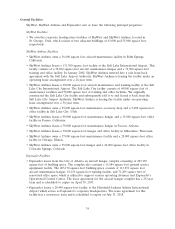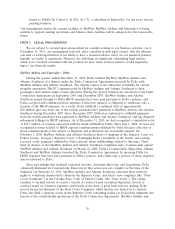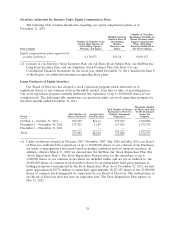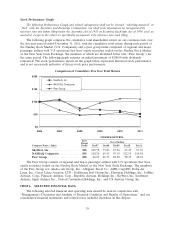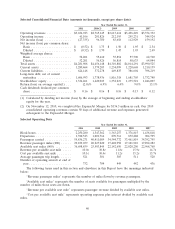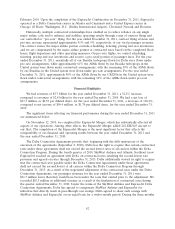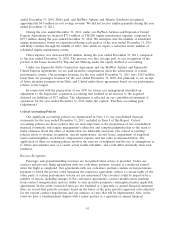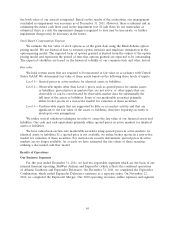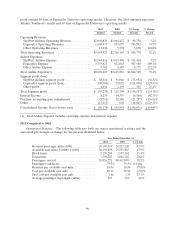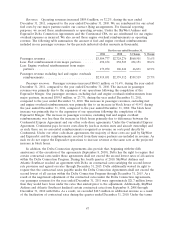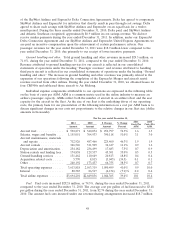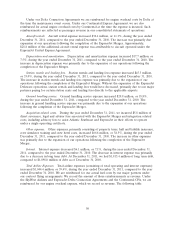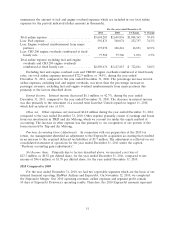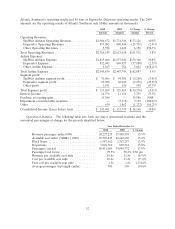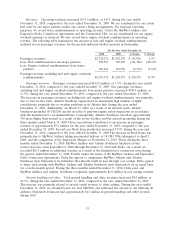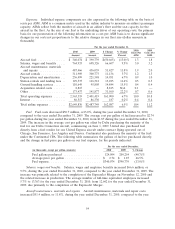SkyWest Airlines 2011 Annual Report Download - page 48
Download and view the complete annual report
Please find page 48 of the 2011 SkyWest Airlines annual report below. You can navigate through the pages in the report by either clicking on the pages listed below, or by using the keyword search tool below to find specific information within the annual report.statement date, we evaluate the dispute under established revenue recognition criteria and, provided
the revenue recognition criteria have been met, we recognize revenue for that period based on our
estimate of the resolution of the dispute. Accordingly, we are required to exercise judgment and use
assumptions in the application of our revenue recognition policy.
Maintenance
We use the direct-expense method of accounting for our regional jet aircraft engine overhaul costs.
Under this method, the maintenance liability is not recorded until the maintenance services are
performed. We use the ‘‘deferral method’’ of accounting for our Brasilia turboprop engine overhauls,
which provides for engine overhaul costs to be capitalized and depreciated to the next estimated
overhaul event or to the remaining useful life, whichever is shorter. For leased aircraft, we are subject
to lease return provisions that require a minimum portion of the ‘‘life’’ of an overhaul be remaining on
the engine at the lease return date. With respect to engine overhauls related to leased Brasilia
turboprops to be returned, we adjust the estimated useful lives of the final engine overhauls based on
the respective lease return dates. With respect to SkyWest Airlines, a third-party vendor provides our
long-term engine services covering the scheduled and unscheduled repairs for engines on our CRJ700s
operated under the SkyWest Airlines United Express Agreement. Under the terms of the vendor
agreement, we pay a set dollar amount per engine hour flown on a monthly basis and the third-party
vendor assumes the obligation to repair the engines at no additional cost to us, subject to certain
specified exclusions. Thus, under the third-party vendor agreement, we expense the engine maintenance
costs as flight hours are incurred on the engines and using the contractual rate set forth in the
agreement.
Aircraft Leases
The majority of SkyWest Airlines’ aircraft are leased from third parties, while ExpressJet’s aircraft
flying for Delta are primarily debt-financed on a long-term basis and the majority of ExpressJet’s
aircraft are leased from Continental for a nominal amount. In order to determine the proper
classification of our leased aircraft as either operating leases or capital leases, we must make certain
estimates at the inception of the lease relating to the economic useful life and the fair value of an asset
as well as select an appropriate discount rate to be used in discounting future lease payments. These
estimates are utilized by management in making computations as required by existing accounting
standards that determine whether the lease is classified as an operating lease or a capital lease. All of
our aircraft leases have been classified as operating leases, which results in rental payments being
charged to expense over the terms of the related leases. Additionally, operating leases are not reflected
in our consolidated balance sheet and accordingly, neither a lease asset nor an obligation for future
lease payments is reflected in our consolidated balance sheets.
Impairment of Long-Lived Assets
As of December 31, 2011, we had approximately $2.9 billion of property and equipment and
related assets. Additionally, as of December 31, 2011, we had approximately $19.5 million in intangible
assets. In accounting for these long-lived and intangible assets, we make estimates about the expected
useful lives of the assets, the expected residual values of certain of these assets, and the potential for
impairment based on the fair value of the assets and the cash flows they generate. We recorded an
intangible of approximately $33.7 million relating to the acquisition of Atlantic Southeast in September
2005. The intangible is being amortized over fifteen years under the straight-line method. As of
December 31, 2011, we had recorded $14.2 million in accumulated amortization expense. Factors
indicating potential impairment include, but are not limited to, significant decreases in the market value
of the long-lived assets, a significant change in the condition of the long-lived assets and operating cash
flow losses associated with the use of the long-lived assets. On a periodic basis, we evaluate whether
44


